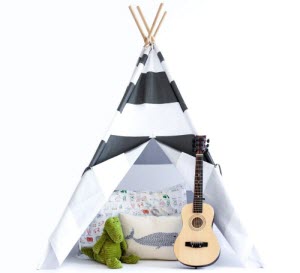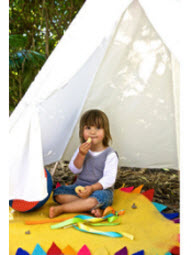A Teepee (or tepee, tipi or tee pee) is a cone-shaped tent, traditionally made of game animals’ hides draped over wooden poles. However these days in 2017 mini versions can be found in children’s rooms, basement play areas, family rooms or outside in the yard with kids playing inside. Having a tepee for your child is a cute gift that will allow them to use their imagination and learn through play at the same time. Teepees can look great in just about any setting around to home so they can be a feature as well as a great place for kids to play.
Click below to see the best Range of Kids Teepees available online today.
Below we have put together a great list of ideas to help kids to get the most out of their teepees.
10 Great Things to do with a Kids Teepee

- Let kids Learn about the Plains people who used to live in Teepees.
Teepees were part of a way of life. Although that way of life was often caricatured in “westerns,” it’s fascinating for most children. Charles A. Eastman wrote about what children who lived in tepees learned and did in a book called Indian Scout Craft and Lore. Among other historical things to do with teepees, he describes how they made toys and played games. His presentations to Boy Scouts, Girl Scouts/Guides, Camp Fire Girls and similar groups were aimed at “teens and tweens” however these stories can easily be adapted to suit the younger children who are likely to play in a Teepee today.
Not all readers realize that Charles Eastman’s “tribesmen” are still alive today. Their name for themselves is either Dakota, Lakota, or Nakota, depending on which part of the central North American Plains they live in. It means “friendly, peaceable people.” Although they were tough, successful warriors when they went to war, these people preferred to trade with others they encountered on the Plains. They still like to trade make all kinds of things is this day also.
- Give something back to the Plains people.
If you are going to set up a Teepee in your yard, part of the tradition is giving something to the people who invented tepees. Since these people have less prairie to roam on and fewer buffalo to hunt than they used to have, they are not wealthy. Some of them are very poor. While sitting in a Teepee, children might like to think about something they might give to a Dakota child. Food, warm clothes and shoes, strings and ropes, beads, and hair ornaments were things children would have exchanged in “olden days.” Nowadays, you might be able to ask someone how to send a present to Plains Indian children, or find a legitimate charitable fund online.
Sharing food was an important tradition in most Native American cultures. The only way they could preserve food was to dry it over a fire, which took a long time and didn’t work well in rainy weather. When there was plenty of food, they gave feasts for all of their friends and neighbors. This was sometimes a source of misunderstanding with European immigrants, who often cooked delicious food and then tried to preserve it instead of sharing it with friends while it was fresh. A traditional thing for kids to do with a Teepee is to “raid” their parents’ grill for food to eat in or beside their tents.
Plains people were not vegans, but they didn’t have meat or fish every day. They ate buffalo meat and other kinds of meat when they could. Chili bean soup with corn tortillas would be similar to a Plains feast. Jerky warmed up in a bowl of green vegetables would be more of an everyday meal. For dessert, they might be lucky enough to have some mixed berries. Although the tepees were used by hunting-and-gathering nomads when they were following a buffalo herd, many Plains people encouraged fruit and vegetable crops, and stayed close enough to plant food supplies long enough to harvest the fruit.
The friendly traders (Dakota, Lakota, and Nakota people) were able to eat things that didn’t grow on the Plains when they met people carrying food to trade. They probably didn’t get a lot of apples and oranges, wheat bread, or cheese…but they probably enjoyed such exotic foods when they did get them.
Plains children probably spent most of their time with their mothers gathering plant foods. If you know where to find plants that are safe to pick and eat, a trip to gather food would be a good way to prepare for a feast.
Keen to get your own teepee for the house or backyard? See our article on the best place to buy teepees.
- Dance around the Teepee.
Most Native Americans had traditional dances for all kinds of occasions. Adults’ dancing was often part of a prayer or religious ceremony. Children danced just for fun.
Plains people made their own musical instruments to accompany dances. These were very simple instruments like drums, rattles, and bells. Children could make these instruments and probably did. Anything that makes an interesting noise when struck rhythmically would work as a musical instrument. A hollow log hit with a stick was one popular kind of drum. A large, clean, empty metal can with a piece of leather or rubber tied over the open end is another traditional kind of drum that was much used in the nineteenth century. Seeds that rattle in pods were sometimes used as musical instruments.
- Write and sing songs.
For some Plains people, the rule was that each person sang his or her own original songs. Singing other people’s songs was sometimes considered a kind of stealing. There are recordings of Native American songs that are interesting to listen to, but it might be more fun to sing your own original songs in a Teepee. A suitable song can be very simple, even childlike. “Hello, birds up in the tree! I see you from my Teepee.”
Songs were shared around the campfires between the tepees. Sometimes these campfire songs helped people who might not speak the same language feel like buddies in camp. These songs often had “yah, hey, ho” refrains that were easy for everybody to learn and join.
- Tell stories.
Stories told around the campfire were often about hunting, fishing, or war. Those who had brought home food to eat, treasures stolen from enemies, or gifts or trade goods from friends, would tell how they had obtained these things. Children would listen carefully to learn how they, too, could bring home good things.
Other stories were told to amuse and instruct children. These stories might involve cartoon-like characters who acted a little like animals and a little like humans. Sometimes they taught lessons about how children should or should not behave. Sometimes they were about terrible things that happened to misbehaving children, or creatures or beings that might attack misbehaving children. Sometimes they were told just for laughs. Silly and scary stories are still popular around campfires today.
Native American children were usually taught to be quiet, especially among people they didn’t know well. Sometimes they seemed to be shy when they were actually practicing good manners–showing respect and paying attention. Children who cried, shouted, or laughed out loud might be shushed by their parents, or even have cold water thrown in their faces, to remind them not to make noises that might attract predators–animal or human. In the “olden days” it was a useful survival skill to seem equally quiet, serious, and cool-headed whether you liked or trusted another person or not. When everyone was together around the fire, it was safer for children to laugh or yell along with older people.
- Make your own clothes and ornaments.
Children whose parents lived in tepees might go out to gather food with their mothers, or stay in the tepee and work quietly, depending on the weather. Mothers kept busy making useful things like clothes, shoes, blankets, ropes, and dishes. Although we no longer have to wrap dead animals’ hides around ourselves, children who are old enough to handle needles and scissors may enjoy making some of the kind of simple possessions that were used in the original tepees.
Successful hunters and gatherers made clothes and decorations out of things they found and did not eat. One kind of decoration was a simple bag hung from a belt or necklace. When Plains people started learning English they called these bags medicine bags. The bags might carry seeds or roots of plants for planting next year, dried leaves or flowers for herb tea or “magic” smoke, and all kinds of other little souvenirs. Children can make medicine bags from cloth or paper.
“Feather bonnets” were worn by successful hunters, who shot and trapped all kinds of birds. Plains children didn’t wear them. They might have had long enough hair to tuck flower stems into the braids as decorations.
Stringing beads was a useful skill since beads could be traded like money. Decorative beads were first made from seeds and porcupines’ quills. Later the Plains people traded for more colorful glass and crystal beads.
- Play games and run races around your Teepee.
Plains children spent a lot of their time doing useful work–hunting and gathering food, collecting fuel, tending fires and stirring pots of stew over the fires, lashing together sticks to make frames for drying food or hauling things around. Growing up strong and fast was important, too, so when they weren’t doing chores children were encouraged to run races and play games. They played ball games like soccer and dodgeball, competitive games like capture-the-flag, and games of skill like throwing darts or pebbles at targets.
Running, jumping, swimming, wrestling, riding, throwing, and catching were not just idle pastimes for Plains people. They were survival skills. Parents were pleased to watch their children doing these things well.
- Sleep in your Teepee.
A frame of sticks and ropes or thongs, with some dried grass for padding and some animal skins for warmth, was a luxurious bed in a Plains camp. People who hunted and gathered all day got tired enough to sleep on bare ground, in spite of chills and insect bites. (Smoke discouraged insects. So do fresh cucumber peelings left in a Teepee overnight.) Still, Plains people used animal skins to improvise something like ground sheets and sleeping bags when they could, and traded for ground sheets and sleeping bags when they had that option.
Knots and lashing, picture “writing,” sign language, dog training, and grinding dried grains and spices were other things kids traditionally learned to do in tepees. The more time parents and children spend “unplugged” in the Teepee, the more fun they can have, and the more skills they can learn through play.
- Try Build a Traditional Teepee.
If you have a lot of sturdy sticks and branches, you can build a traditional tepee by pushing the ends down into the ground and lashing the tops together so they form a cone shape. Then wrap the hides or blankets around the sticks, leaving a little smoke hole at the top. A traditional tepee did not have a bottom. It was set up on the bare ground. A very small, carefully watched fire could be built on the ground below the smoke hole. If the fire got out of control, the owners of the tepee might be able to get out, or pull the tepee or part of it away from the flames…or they might lose their tepee, or start a prairie fire. Children may need to be reminded why this is not a good idea. These individual fires helped people stay warm at night in very cold weather, but the main campfire was outside, on the ground between the tepees. That was where people cooked and ate food, danced, sang, and told stories.
If you live in a more typical urban or suburban environment, kids can build a pretend tepee by draping blankets over chairs and coat racks. Or you can buy a prefabricated Teepee and let the kids help set it up in the yard. The prefabricated Teepee may be made of nylon and is not a good place to have anything that is or may become hotter than your wrist. (This is also applicable to many blankets sold today).
If you like these ideas and think that getting a teepee would be a lot of fun for your child check look here for prices and different designs.



